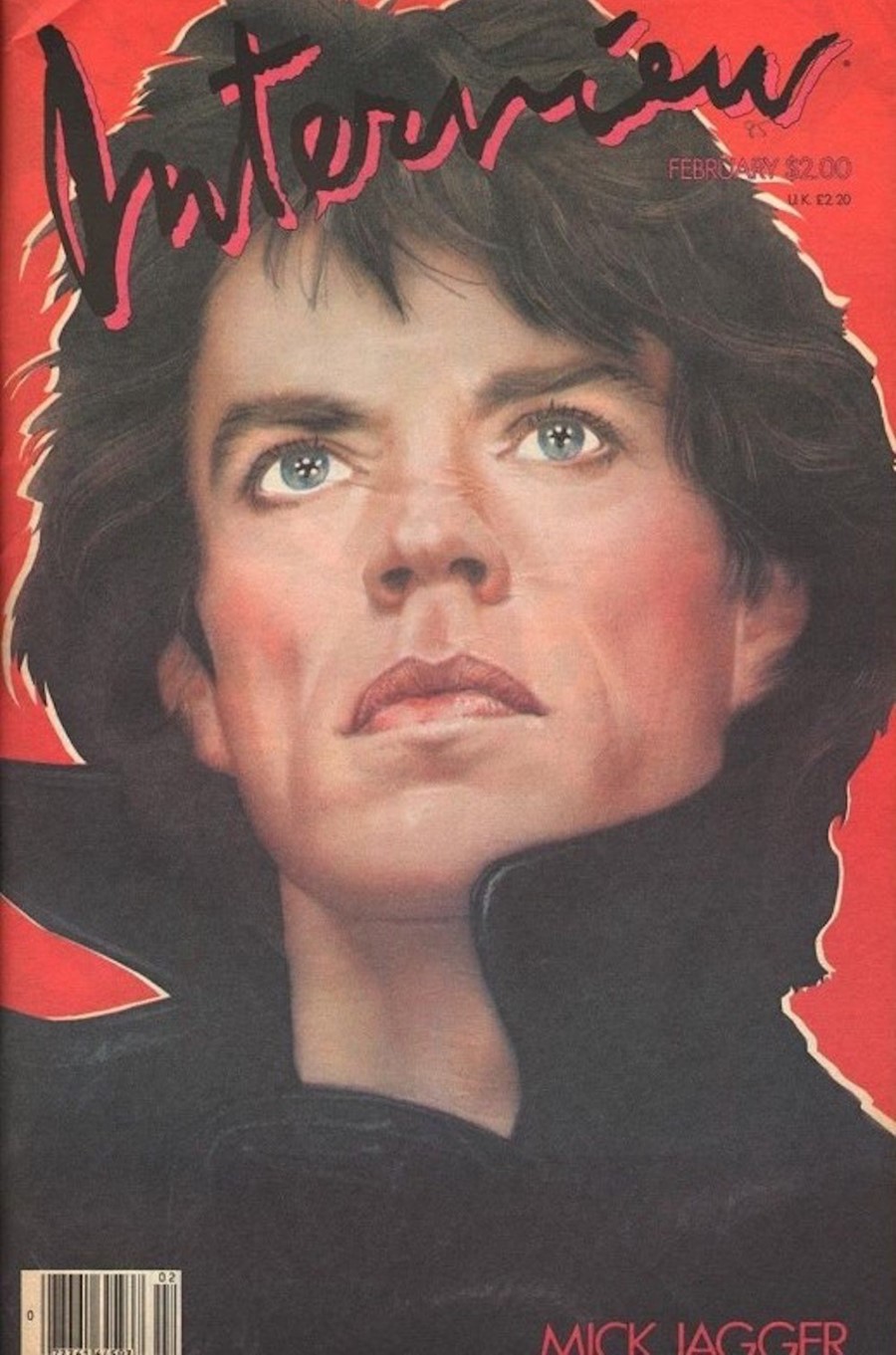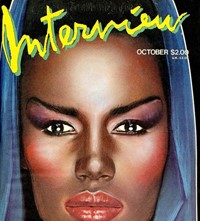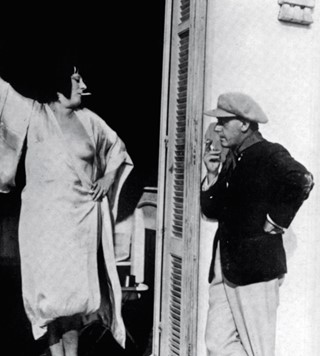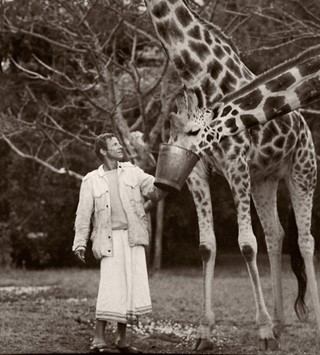Remembering Interview Magazine Through Stories of Those Who Worked There
- TextMiss Rosen
In tribute to publication, which has just announced its closure, five former editors and contributors share their memories of working alongside Andy Warhol, Glenn O’Brien and Ingrid Sischy
Last week, nearly 50 years after it first launched, Andy Warhol’s Interview magazine announced that it was ceasing publication. The large format periodical, which began as a ‘Monthly Film Journal’ in an effort to entice Hollywood to bankroll and distribute Warhol’s films, evolved over a period of five decades to become ‘The Crystal Ball of Pop’, chronicling the downtown scene.
Interview was the ultimate Warholian project, giving readers insider access to the pop cultural elite through a compelling blend of glamour photography and celebrity-on-celebrity conversations that sprawled decadently across the oversize pages of the magazine. From 1972 to the late 80s, Richard F. Bernstein gave it a stamp of distinction with his exquisitely rendered portraits of everyone from Grace Jones, David Bowie, and Diana Ross to Debbie Harry, Michael Jackson, and Bob Marley, among many others.
Under the auspices of editors like Bob Colacello, Ingrid Sischy, and Glenn O’Brien, Interview constantly reinvented itself, striking the perfect balance between art and celebrity, just like Warhol himself. Here, a handful of editors and contributors share their memories of working alongside Andy, Glenn, and Ingrid over the years.
PAT HACKETT
Pat Hackett worked closely with Andy Warhol for 20 years, coauthoring two books (The Andy Warhol Diaries and POPism: The Warhol Sixties), as well as a screenplay. Hackett was Senior Editor of Interview from 1969 through the 1980s.
“Interview was very different in the beginning. Andy did not tell me why he wanted to start Interview. At that time, Gerard Malanga was still at the Factory and the explanation in many places was that Andy wanted to give Gerard something to do.
There was a period in the beginning when the magazine was being edited and no one was reading it downstairs. Suddenly Andy or Paul saw a copy of the latest issue and said, ‘What’s going on?’ There was a reckoning. When Bob Colacello and Glenn O’Brien became the editors, they really integrated it into Andy’s everyday life.
“Andy had a great sense of the importance of doing something that people couldn’t find anywhere else” – Pat Hackett
Everyone who worked at the Factory was on the masthead and whatever we happened to do for the magazine was extra. When Andy interviewed somebody I would redact them. In the late 70s or 80s, I started doing cover interviews myself. I did Sylvester Stallone, Don Johnson, Eric Roberts, and Mickey Rourke. I think David Letterman was the first cover I did. I remember Andy was shocked when I told him. I don’t think he ever did an interview alone.
My role varied over the years. I enjoyed working with Matthew Rolston in the 80s; he always had a theme in mind and was very observant. Andy wanted details where you could look at it and say, ‘Oh, that’s the Interview shoot.’ Andy had a great sense of the importance of doing something that people couldn’t find anywhere else.”


MATTHEW ROLSTON
Matthew Rolston is an American photographer and author of Hollywood Royale: Out of the School of Los Angeles (teNeues, 2017). He worked as an editorial photographer for Interview from 1977 to the 1980s.
“I was a student at Art Center College of Design in Pasadena when I started to work for Interview. My older brother Dean Rolston had a young, scrappy gallery in New York City called 56 Bleecker. I got to meet a lot of the younger circle around Andy Warhol and Interview when I would visit him on breaks, so people there knew my name.
I was contacted by the West Coast editors after a photographer assigned to shoot something in California refused. Within a couple of days I was doing the assignment for them, which was my published work of any significance: a portrait of Steven Spielberg in 1977. The magazine liked the work and other assignments began to come, including cover stories for Michael Jackson, George Michael, Debra Winger, and Molly Ringwald.
“If Andy was in the office, there would be a lunch with very interesting people. On that particular day, the guests were Duran Duran and Nancy Reagan. Nobody could mix high and low like Andy” – Matthew Rolston
I remember one of the first times I got to go to the Factory. Andy and Fred held court in his office, which had a Jacques Ruhlmann conference table, huge art deco doors in the doorway, and some columns with taxidermy Doberman Pinschers guarding the entrance.
If Andy was in the office, there would be a lunch with very interesting people. On that particular day, the guests were Duran Duran and Nancy Reagan. Nobody could mix high and low like Andy. I think Brigid Berlin was the receptionist, or at least the gatekeeper. This was all a very eccentric high style world, just fantastic and I was thrilled to be a small part of it.”


CHRISTOPHER MAKOS
Christopher Makos is an American photographer and author of 22 books including the seminal 1977 monograph White Trash. He had a monthly column for Interview from 1980 through 1987.
“Bob Colacello had a column called ‘Out’ in Interview. When his contract was up, Bob had asked for 51% of the magazine; Andy didn’t go for that so Bob left the magazine. Andy said, ‘Chris, why don’t you do the column?’ That’s how my column, ‘In’, began.
The great thing about working with Andy was that he trusted my opinion. I had creative and artistic freedom for my two pages, which was both a blessing and sometimes a curse because you are in the position of finding stuff every 30 days, which can be quite daunting. For me, it wasn’t just find one story; I had ten or 15 micro-stories for the column – but I had that kind of energy and I still do.
“The great thing about working with Andy was that he trusted my opinion. I had creative and artistic freedom for my two pages, which was both a blessing and sometimes a curse” – Christopher Makos
Creativity comes from the bottom and goes up; it doesn’t come from the top and go down. You have to see what is happening on the streets. My thing was to find new people like Pedro Almodóvar, Christian Slater, Robert Downey Jr., and Matt Dillon.
No one would ever remember this but Häagen-Dazs came out with vanilla ice cream on a stick covered in chocolate. They sent ice cream to my studio and did a demonstration where they hand dipped them in the chocolate and that’s something I published in my column. It was a really abstract and obtuse thing; no one would ever cover the debut of ice cream on a stick now (laughs). It was a very different time.”


STEPHEN GRECO
Stephen Greco is an American media executive and author of seven books. He was senior editor for Interview from 1990 through 1994.
“I started working at Interview just after it had been taken over by Peter Brant and moved to 575 Broadway. Ingrid Sischy had marvelous ideas about how to move the magazine forward. Andy had unguarded conversations with very smart people from all walks of life. Ingrid wanted to regularise it and stabilise it, not just plunk a tape recorder down in a restaurant and talk about whatever, but to get into serious creative issues.
Ingrid taught me that you have to maintain a balance in your mind between an attitude of ‘It could be nothing’ and ‘It might be everything.’ She had access to both sides of her mind and could access both instantly. I remember once we were looking at photographs of a grey sky, that’s all, and she said, ‘It’s empty – but it is the right kind of empty?’
“One day this little girl was standing outside. They wouldn’t let her in because she didn’t have an appointment. She had a guitar and wanted to play for me and Dimitri Ehrlich, the music editor – and it was Sarah McLaughlin” – Stephen Greco
I could see her being attracted to something but really being rigorous. Her mind was faster than anyone else’s I had ever met. She even referred to the lives we all lived at Interview as ‘that fast thing’. She meant the life in the media where you see a million things and had the chops to make judgments.
It was also a time when artists would show up unannounced. One day this little girl was standing outside. They wouldn’t let her in because she didn’t have an appointment. She had a guitar and wanted to play for me and Dimitri Ehrlich, the music editor – and it was Sarah McLaughlin.”


LUCY SILBERMAN
Lucy Silberman is the managing editor of Maxim magazine. She joined Interview in 2007 as Assistant Editor and rose to Associate Managing Editor before she left in 2010.
“I started working at Interview during Ingrid Sischy and Sandra Brant’s last years running the magazine – before Glenn O’Brien, Fabien Baron, and Karl Templer came into to do the redesign of the book. It was a very interesting time: I was exposed to different viewpoints, areas of expertise, and histories with the magazine.
Both regimes were comprised of very lean teams of high-performing individuals. I would describe the office culture as a controlled chaos. It was an all-hands-on-deck situation at all times. In my early days as an Assistant Editor, I was the one connecting the calls between artists. I remember once we did an interview with Björk and she was on a houseboat in Guatemala. There were all these weird looks into the personal lives of celebrities in genuine way.
“I remember once we did an interview with Björk and she was on a houseboat in Guatemala. There were all these weird looks into the personal lives of celebrities in genuine way” – Lucy Silberman
Both Ingrid and Glenn wanted to channel Andy’s vision of the magazine as something special and bespoke, and they pushed their staff accordingly. The transition period was challenging. There was a shadow magazine happening, where Ingrid was still there and Glenn was there in a separate office. I was moving into a managing editorial role and was acutely aware of hours passing, days passing, and things still not being done.
Now that I am a few years past that I can better appreciate the creative challenges they were facing – but at the time I was concerned we weren’t going to get there. You always get there, though.”
















